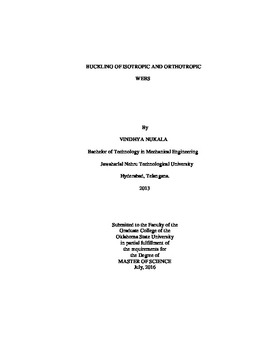| dc.contributor.advisor | Good, James Keith | |
| dc.contributor.author | Nukala, Vindhya | |
| dc.date.accessioned | 2017-02-22T22:15:58Z | |
| dc.date.available | 2017-02-22T22:15:58Z | |
| dc.date.issued | 2016-07-01 | |
| dc.identifier.uri | https://hdl.handle.net/11244/49128 | |
| dc.description.abstract | A web is a material that is very long compared to its width. Webs are usually quite thin compared to their width dimension and are stored and transported in the form of rolls. Webs are often subjected to several continuous processes in which value is added prior to manufacturing a final product. During these processes the web is first unwound and then transported over a series of rollers, some of which are driven and others not, through the process and then finally rewound to await the next process. The direction in which web is travelled is called as the machine direction and the direction orthogonal to machine direction but still within the plane of the web is called as the cross machine direction. The objective is to transport these webs through processes with minimal defects and economic loss. Due to the small thickness of the web, the bending stiffness of the web is also small, and web tension is often sufficient to take the shape of the roller surface as the web transmits the roller. The unsupported web between rollers is called a free span and in good processing conditions, this web has the form of a flat plate in free span. Often web instability can be witnessed in free span called web troughs. The web troughs form because of compressive stresses in cross machine direction. Good and Beisel has estimated the critical compressive required to induce troughs and estimated the wavelength of troughs in webs. Cerda et al developed an inextensibility theory to predict the amplitude of troughs in isotropic webs. A closed form expression to predict the troughs amplitude and wavelength could be very useful. Most of the webs have orthotropic material properties. This research is to extend the inextensibility theory to orthotropic webs and to verify the theory of elastic isotropic and orthotropic web materials. The validity of the troughs amplitude and wavelength expressions will be achieved through laboratory tests and nonlinear finite element simulations. Furthermore, limitations of these expressions will be studied. | |
| dc.format | application/pdf | |
| dc.language | en_US | |
| dc.rights | Copyright is held by the author who has granted the Oklahoma State University Library the non-exclusive right to share this material in its institutional repository. Contact Digital Library Services at lib-dls@okstate.edu or 405-744-9161 for the permission policy on the use, reproduction or distribution of this material. | |
| dc.title | Buckling of Isotropic and Orthotropic Webs | |
| dc.contributor.committeeMember | Delahoussaye, Ronald D | |
| dc.contributor.committeeMember | Wang, Shuodao | |
| osu.filename | Nukala_okstate_0664M_14811.pdf | |
| osu.accesstype | Open Access | |
| dc.description.department | Mechanical & Aerospace Engineering | |
| dc.type.genre | Thesis | |
| dc.type.material | text | |
